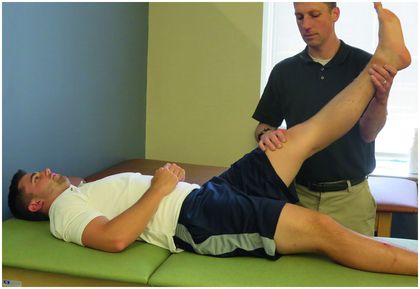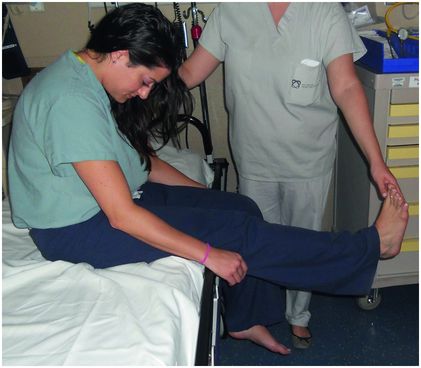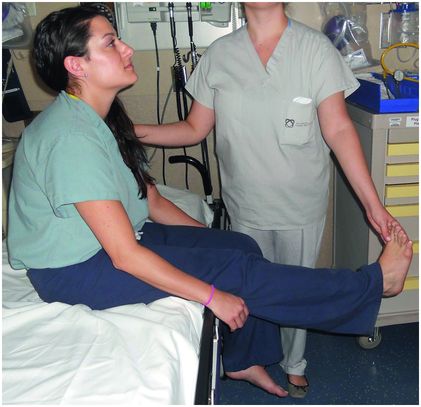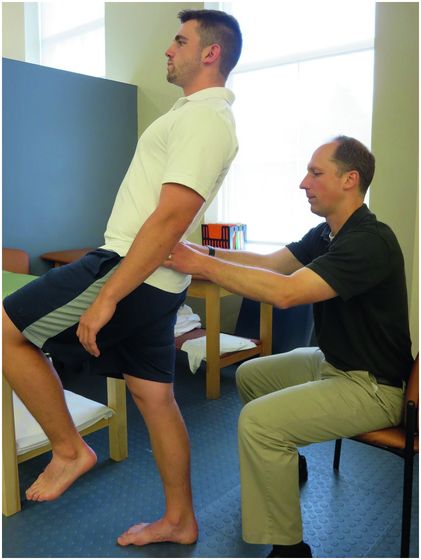Bony anatomy of the lumbar spine, lateral view.
Focused History and Physical Exam
General Considerations
Historical “red flags” should alert the clinician to serious causes of low back pain, such as infection, malignancy, and fracture. (Table 10.1); however, many of these red flags are poorly studied and may offer little diagnostic or predictive value.
Extraspinal causes of low back pain should always be considered in the differential diagnosis of low back pain, including abdominal aortic aneurysm (AAA), retroperitoneal hemorrhage or mass, nephrolithiasis, and urinary tract infection.
Patients at the extremes of age warrant special consideration as children and elderly individuals are more likely to have serious causes of back pain.
Four predictors of serious pathology in adults presenting to the ED with nontraumatic low back pain (91 percent sensitivity, 55 percent specificity)3 have been identified:
Pain that persists despite appropriate treatment.
Use of anticoagulant medications.
Decreased sensation on physical examination.
Pain that is worse at night.
Axial pain suggests disc disease, while paraspinal pain suggests sacroiliac or facet disease.
| Historical Red Flags1 | Risk factors for Spinal Epidural Abscess10 |
|---|---|
| Persistent pain lasting >6 weeks | Intravenous drug use |
| Fever/chills | Diabetes |
| Unexplained weight loss | Chronic liver or kidney disease |
| History of cancer | Recent spine procedure or indwelling hardware |
| Intravenous drug use | Concomitant infection |
| Chronic steroid use | Indwelling vascular catheter |
| Night pain | Recent spine fracture |
| Unremitting pain despite analgesics | Immunocompromise |
| Immunocompromise | |
| Major trauma | |
| Minor trauma in the elderly | |
| Bowel/bladder dysfunction | |
| Recent bacterial infection |
Physical Exam
Gait assessment
Heel-walking and toe-walking may be used in the assessment of L4 and S1 motor function, respectively.
Inspection
Assess for swelling, deformities, skin changes, scoliosis, asymmetry.
Evaluate for rash suggestive of herpes zoster.
Palpation
Distinguish axial vs. paraspinal tenderness, as well as focal vs. diffuse tenderness.
Range of motion
Flexion, extension, lateral rotation, and side-to-side bending should be assessed.
Increased pain with flexion suggests disc herniation.
Increased pain with extension suggests spinal stenosis, spondylolisthesis, or facet disease.
Neurologic examination
Focuses on assessment of spinal nerve root function and includes testing of muscle strength, sensation and deep tendon reflexes (Table 10.2 and Table 10.3).
Bowel or bladder complaints should prompt testing of perianal sensation and rectal tone.
Bladder function (e.g., urinary retention, overflow incontinence) may be assessed. with evaluation of post-void residual volume or bedside ultrasound.
Vascular examination
Palpate dorsalis pedis pulses
Assess capillary refill
Special tests
Straight leg raise (SLR) (Figure 10.2) is performed with the patient in a supine position, and the hip is passively flexed with the knee in extension.
Reproduction of radicular pain below the knee during hip flexion from 30–70° indicates a positive test and suggests nerve root compression from a herniated disc (sensitivity 91 percent, specificity 29 percent).4
Braggard’s test is performed after SLR by lowering the leg and then dorsiflexing the ankle to evaluate for reproduction of radicular symptoms.
Crossed SLR is positive when radicular symptoms are reproduced on the affected side by raising the contralateral leg (sensitivity 29 percent, specificity 88 percent).4
The slump test (aka slump sit test) is a variant of the SLR and is sensitive for disc herniation. With the patient seated at the edge of the bed and leaning forward, cervical flexion is initiated followed by knee extension and ankle dorsiflexion (Figure 10.3). The patient is then asked to bring their neck back into the neutral position (Figure 10.4). The test is positive if radicular symptoms are reproduced in the slump position and relieved as the patient brings the neck back into the neutral position.
The stork test is a classic test for spondylolysis but has poor sensitivity and specificity. A positive test results from ipsilateral pain with the patient standing on one leg and extending the lumbar spine (Figure 10.5).
Waddell signs are a group of physical exam findings that attempt to differentiate pathologic back pain from nonorganic back pain; positive findings may be associated with worse outcomes and psychosocial factors but not necessarily secondary gain.
May indicate symptom magnification but do not exclude organic disease.
Superficial, diffuse, or nonanatomic tenderness.
Pain provoked by simulated movements, such as axial loading of the head or rotation of the shoulders.
Positive tests are performed again while distracting the patient.
Sensorimotor findings that are nondermatomal.
Gross overreaction to testing.
| 0 | Total paralysis |
| 1 | Visible or palpable muscle contraction |
| 2 | Active movement, full range of motion, with gravity eliminated |
| 3 | Active movement, full range of motion, against gravity |
| 4 | Active movement, full range of motion, against gravity, provides some resistance |
| 5 | Active movement, full range of motion, against gravity, provides normal resistance |
| NT | Unable to test |
| Nerve Root | Motor | Sensory | Reflex |
|---|---|---|---|
| L2 | Hip flexion | Anterior and medial thigh | None |
| L3 | Knee extension | Medial knee | None |
| L4 | Ankle dorsiflexion | Anterior knee and medial lower leg | Patella |
| L5 | Great toe extension (EHL) | Dorsal foot | None |
| S1 | Ankle plantarflexion | Posterior thigh and calf | Achilles |

Straight leg raise.

Slump test with neck flexion, knee extension and ankle dorsiflexion.

Slump test with neck in neutral position.

Single-leg hyperextension, or stork test.
Diagnostic Testing in the ED
Routine imaging is generally not indicated in patients presenting to the ED with acute, atraumatic low back pain in the absence of risk factors or exam findings suggestive of serious pathology.
Consider imaging for acute low back pain after trauma.
Minor trauma may cause fractures in elderly, immunocompromised, or cancer patients.
Identification of any spine fracture warrants imaging of the entire spine.
Laboratory studies provide little diagnostic value unless malignancy or infection is suspected.
Consider PT/INR if patient is on anticoagulation.
Advanced imaging (i.e., MRI) in the ED is reserved for patients with severe or rapidly progressive neurologic deficits, or with signs and symptoms of serious underlying pathology (infection, malignancy, cord compression).
Advanced diagnostic imaging in the outpatient setting may be considered for failure of conservative management (NSAIDs, physical therapy) after six to eight weeks.
Differential Diagnosis – Emergent and Common Diagnoses
Thoracolumbar (TL) Spine Trauma
TL spine fractures occur most commonly between T12 and L2 and spinal cord injury (SCI) occurs in 10–25 percent.5
TL fractures usually result from motor vehicle trauma and falls from height (65 percent); the remainder are caused by athletic participation and assault.6
Treatment is directed toward spine stabilization and preservation of neurologic function.
Most TL spine fractures are stable and may be managed nonoperatively.
High-dose steroids are no longer recommended in the acute management of traumatic SCI due to lack of evidence and potential for significant adverse effects.
There is no existing clinical decision tool that allows for “clearance” of the TL spine or guides the need for imaging following blunt trauma.7,8
Current practice for clinical and radiographic evaluation of the TL spine, though not evidence based, often mirrors evaluation of the cervical spine for which validated guidelines exist (e.g., NEXUS criteria).
CT often replaces screening radiographs in the patient with high suspicion for fracture.
Classification systems
Denis classification system
Widely used in clinical practice but may lack predictive value.
Based on radiographic findings and uses a three-column theory to identify instability.
Compromise of two or more columns suggests unstable injury.
Anterior column = anterior longitudinal ligament and anterior half of vertebral body.
Middle column = posterior longitudinal ligament and posterior half of vertebral body.
Posterior column = pedicles, facet joints, and supraspinous ligaments.
Thoracolumbar injury classification and severity score (TLICS).
Newer classification system that is both comprehensive and reliable in determining injury severity and guiding treatment.9
TLICS is based on three parameters.
Fracture morphology
Neurologic status of the patient
Integrity of the posterior ligament complex
| Emergent Diagnoses | Common Diagnoses |
|---|---|
| Lumbar spine fracture: Burst fracture Flexion-distraction injury (Chance fracture) Fracture-dislocation | Mechanical low back pain |
| Infection: Spinal epidural abscess Vertebral osteomyelitis and diskitis | Lumbar disc disease |
| Neoplasm | Lumbar radiculopathy |
| Cauda equina syndrome | Myofascial lumbar strain |
| Any common condition with severe or progressive neurologic impairment (i.e., compression, fracture, spinal stenosis, spondylolisthesis) | Lumbar spinal stenosis |
| Extraspinal causes: Abdominal aortic aneurysm Retroperitoneal hemorrhage or mass | Spondylosis (degenerative osteoarthritis) |
| Spondylolisthesis | |
| Spondylolysis | |
| Sacroiliac joint dysfunction | |
| Lumbar compression fracture |
Vertebral Compression Fracture
General Description
Considered a fragility fracture
Usually stable fractures affecting only the anterior column.
May be unstable if more than 50 percent loss of vertebral body height or more than 20–30° of kyphosis, multiple adjacent fractures, or involvement of posterior elements.
Increased frequency in elderly related to osteoporosis.
Mechanism
Trauma with anterior or lateral flexion causes injury to the anterior column.
May result from minor trauma in osteoporotic patients; some may not recall trauma.
Presentation
Pain is often localized to the area of fracture but may radiate around the torso in some cases.
Physical Exam
Tenderness is localized to the fracture site and local kyphosis may also be evident
Pain is often midline, but may also be paraspinal.
Neurologic deficits are uncommon.
Essential Diagnostics
Plain radiographs will demonstrate loss of vertebral height.
CT is generally unnecessary but may be used to better characterize fracture and may better assess injury to the posterior column.
MRI is often unnecessary but may be useful to distinguish acute vs. chronic fracture and should be considered for any signs of spinal cord compression.
ED Treatment
Most patients are treated with observation and pain management.
Some patients may benefit from bracing with thoracolumbar orthosis (TLSO).
Usually not needed if minimal compression.
Early ambulation is encouraged.
Surgical decompression is rarely indicated except in cases of progressive neurologic deficits or spine instability.
Disposition
Most patients may be discharged home with adequate pain control and orthopedic or neurosurgery follow-up.
Some may require hospitalization for pain management.
Patients with simple compression fractures may return to sports or nonstrenuous occupations once pain is minimal, they have regained near normal range of motion, and there is no evidence of progressive deformity, usually eight to twelve weeks.
Isometric back extension and strengthening exercises may be started at this time.
Consult orthopedics or neurosurgery for unstable fractures, associated neurologic impairment, more than 50 percent vertebral height loss or more than 20 percent angulation.
Complications
Associated spinal cord compression is rare.
Kyphoplasty is reserved for failed medical management and persistent, severe pain for greater than six weeks.
Pearls and Pitfalls
Pathologic fracture should be considered in younger patients without trauma or osteoporosis.
Consider Chance fracture in patients with high-energy trauma; posterior column injury is an important distinguishing feature and may require advanced imaging.
Spinous Process and Transverse Process Fractures
General Description
These fractures usually do not affect the stability of the spine and are benign.
Often times may involve more than one vertebrae.
Mechanism
Transverse process fractures usually result from a lateral bending force which causes an avulsion fracture.
These most commonly occur at L2, L3, and/or L4.
Spinous process fractures usually result from direct trauma or hyperflexion injuries.
Presentation
Pain at site of injury.
Neurological complaints are rare.
Physical Exam
Tenderness at fracture site and also possibly surrounding paraspinal muscles due to spasm.
Neurological compromise is rare.
These injuries may be accompanied by an ileus, so it is important to perform an abdominal exam and ensure patient is able to tolerate oral intake.
Essential Diagnostics
A minimum of a two-view thoracic and/or lumbar spine x-ray is required.
Closely examine the AP view for transverse process fractures.
Closely examine the lateral view for spinous process fractures.
Advanced imaging with CT or MRI is not indicated in the ED unless there is concern for other associated injuries.
Consider a urinalysis to look for hematuria as renal contusions may be associated with these injuries.
ED Treatment
Pain control
Encourage early ambulation and activity as tolerated.
Bracing is not usually needed for isolated injuries.
Except for significant or severe pain, may consider bracing for comfort.
Disposition
Nearly all of these patients may be safely discharged from the ED unless there is concern for other associated injuries.
Orthopedic or neurosurgical consultation is not usually necessary for isolated injuries.
Patient may follow-up with orthopedics, neurosurgery, or sports medicine within one week from discharge.
Patients may resume normal activity as tolerated over four to six weeks.
Patients may return to sports after they are pain free and demonstrate near normal range of motion.
Complications
Pearls and Pitfalls
Isolated spinous and transverse fractures of the TL spine are usually benign and self-limited.
Always evaluate for associated injuries, including ileus and/or renal contusion.
Burst Fracture
General Description
Spine fracture related to compressive load and associated with significant mechanism of injury.
Most occur at the TL junction.
Fracture may be stable despite failure of the anterior and middle columns; adequate assessment of the posterior column is critical in determining the extent of injury.
Mechanism
Results from axial and/or flexion loading and failure of the anterior and middle columns.
Presentation
Canal compromise and neurologic deficits may result from retropulsion of bone.
Physical Exam
Often tenderness at fracture site
Comprehensive neurologic exam is mandatory.
Evaluate for concomitant spine and/or pelvic fractures.
Essential Diagnostics
Plain radiographs demonstrate kyphotic deformity and retropulsed bone fragments.
Increased space between spinous processes may indicate ligamentous injury and associated instability of the fracture.
CT is indicated to better characterize fractures identified on plain films or in those with neurologic deficits, and it is useful for showing facet joint diastasis indicative of posterior column injury.
MRI may be used to evaluate for spinal cord compression or edema, and to assess the integrity of the posterior ligament complex.
Imaging of the entire spine should be considered as concomitant spine fractures are common.
ED Treatment
Nonoperative management is reserved for stable injuries without neurologic deficits.
Operative management is indicated for unstable fractures, as indicated by neurologic compromise, amount of compression, degree of kyphosis, or injury to the posterior ligament complex.
Disposition
Orthopedic or neurosurgery consultation is recommended for all burst fractures to assist with management and disposition.
Stay updated, free articles. Join our Telegram channel

Full access? Get Clinical Tree








